|
For
Universal Studios, House of Dracula marked
the end of an era. Not only was it the last of its Dracula
films, it also featured the final appearance of two of its
other iconic creations, the Frankenstein Monster and The Wolf
Man, effectively drawing a line under what
has become known as the studio's Classic Horror period.
The times they were a-changin', and the end of the war in
Europe saw a paying public with little enthusiasm for the artificial
horrors being offered up by Hollywood. What's more, monsters
that once terrified were now too familiar to carry the same
dramatic weight. But Universal had one last trick up its sleeve:
throw three of its favourite monsters into one picture
– three times the monsters, three times the thrills, right?
Oh, if only.
As it happens, this was Universal's third stab at multiple monster
stories after 1943's Frankenstein Meets the Wolf
Man and 1944's House of Frankenstein (the Wolf Man came late to the monster cycle and so
only got a single film to himself). Certainly this "the
more, the merrier" approach was reflected in the film's
publicity: "The super-shock sensation of all time..."
screamed the posters. "All together...All terrific...Bringing
all NEW thrills!" At the time, this three-for-the-price-of-one
approach may well have seemed like a viable move, but one thing
horror film history has taught us is that if your movie features monsters
from two or more franchises,
then you have run out of ideas and are getting desperate.
Every screen monster not only has its own specific identity
but also exists within its own unique universe, and in some cases
has its own sub-genre with its own set of rules. As soon
as you put two or more movie monsters from different film
series together then you are violating genre rules even before
you start. At best it's a compromise, at worst
it's ridiculous. And saying it was based on a comic book or a
computer game is not a viable excuse. This sort
of teaming is best left to MTV's hilarious Celebrity
Death Match, where at least getting a laugh is the point of the show.
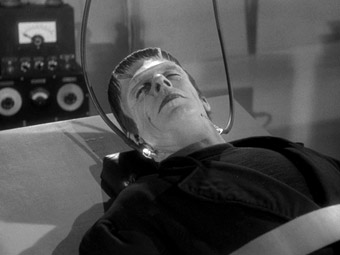
House
of Dracula
actually has more going for it than good many later franchise-blending works,
in part because this was then relatively new territory and
there is thus a degree of innocence to the film that is almost
charming. Almost. Elements of the plot also have plenty of subtextual
potential, but this tends to go largely unexplored thanks to the film's determination to cram in as many
familiar elements as possible, pausing only to allow
characters to woodenly muse on their fate, their destiny,
or man's place in the universe. Despite all this, it does boast a couple of interesting twists on the horror norm, resulting in something of a genre rarity: a film that
actually advances the vampire genre thematically, but is
otherwise not all that great.
It
kicks off with an intriguing notion: Count Dracula turns
up at the office of the renowned Dr. Edelman, explains who
he is and informs the good doctor that he is weary of life as
a vampire and wishes to be cured of the condition. This
would make House of Dracula the first genre film
to propose the concept of vampirism as a communicable and
possibly curable disease, as opposed to the purely supernatural
state suggested by Son
of Dracula. All very interesting, but while
Dracula is attending his second appointment with the doctor,
who should turn up to see him but Lawrence Talbot, aka The
Wolf Man, also looking for a cure for his disorder. Unable to wait, he runs off before the full moon turns him into a beast, and
a short while later tries to kill himself by leaping off
a cliff into the waters below. Edelman tries to save him, but by then the good Talbot has transformed into a lycanthrope and attacks him in a cave
at the base of the cliff. Edelman survives and Talbot recovers,, and the two of them discover
not just a whole crop of the very mould the doctor needs to create cures for both Talbot and Nina, the doctor's beautiful but
hunch-backed assistant, but also – surely not – the seemingly
lifeless body of Frankenstein's monster. I'm surprised they
missed the opportunity to bring The Invisible Man in and
run the old joke about the doctor not being able to see
him. But let's be honest, we knew these three were going
to be in the same film – the publicity told us so. That's
not the issue – it's how the three come to be together
that makes it so hard to swallow. The coincidence factor
smacks of lazy or perhaps hurried writing, and it seems
strange that both Dracula and Talbot have at the very same
moment both chosen a doctor who does not believe in the
supernatural to approach for help. Mind you, they have little
trouble persuading him of their authenticity – Talbot is good enough to transform
just after Edelman has explained away his notions of lycanthropy,
and Dracula provides a blood sample unusual enough to convince
him there must be something in this vampire stuff after
all.
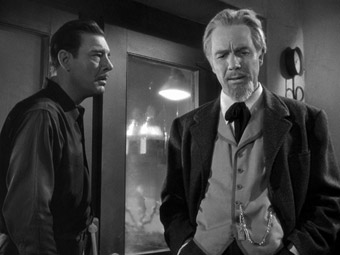
Even
given these disparate elements, the plot bumps along in
less than thrilling fashion, hampered by the over-familiarity
and sometimes dopey behaviour of the characters. Dracula
is so sedately polite, especially on recognising an old
female acquaintance (it is never certain whether he has
used the desire for a cure as a ruse to get near to her or
has by chance stumbled across her when visiting Edelman for treatment
– the opening scene does suggest the former), that when
it does come time for him to be threatening it's something
of a no sale, and by this time Talbot's anguished victim-of-this-curse
routine had become awfully familiar stuff. Frankenstein's monster gets precious little screen
time, and when finally revived he just bumbles around
knocking people and things out of his way.
Of
course, part of the problem of cramming three monsters into
one tale is that in order for them to do their stuff there
have to be secondary characters to aid, fall victim to, and
even destroy them, and presumably to avoid confusing the
audience with multiple stories, most of these duties fall
to the redoubtable Dr. Edelman. Struggling through some
lumpy dialogue and a number of dull scientific explanations,
he in turn plays the roles of skeptical scientist, faith-driven
man of God, werewolf victim, vampire victim, hunted monster,
Van Helsing-like vampire hunter, and even Dr. Frankenstein
himself, all in the extraordinarily short running time of
67 minutes. Not that he sticks at things for very long –
having prepared the monster for revival and presumably rewired
up all of the old equipment needed to effect this process
(he's moved into Frankenstein's old castle, you see), he
disregards the advice of his nurse and Talbot's doomy warnings
and starts the electricity flowing, only to have nursey
remind him that "Man's responsibility is to his fellow
man," which prompts him to respond with, "Perhaps
you're right," and switch the machine off. On occassion, his judgment
can also be called into question. Having identified
Dracula's condition as a possibly unknown blood infection,
he attempts to cure it by transfusing his own blood to the
Count's body by an almost direct link, seemingly unaware
or uninterested in the likelihood of cross-infection. When
it inevitably happens, you can't help thinking the silly bugger had it
coming.
With
so many familiar plot points to cover in such a brief running
time, short cuts are inevitably taken, but this leads to some seriously
clunky moments. Having just met Dracula in his guise of
Baron Latos, Dr. Edelman is asked for his view on the immortality
of the body and, quite unprompted by Latos, goes on something
of a ramble about vampirism and his lack of belief in it,
ending the outpouring with, "What has this discussion
got to do with us?" Well it was you who brought the
whole vampire thing up, mister. Elsewhere speculation on "what could
happen if..." takes place in sometimes
achingly po-faced fashion, with Nina and Miliza
sitting on a moonlit rock formation, gazing disconnectedly in
opposite directions like extras in a low-rent Bergman rip-off
and delivering ponderous one-liners on the perils facing Dr.
Edelman, a laborious recap for the slower audience members.
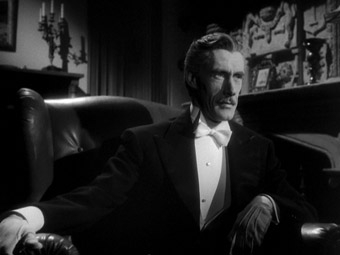
Mind
you, if the script and direction feel stuck in the mud then the performances hardly set the screen alight.
John Carradine's stately Dracula and Lon Chaney's noble but
angst-ridden Lawrence Talbot are functional if lacking in
spark, but as the good Dr. Edelman, Onslow Stevens is called to flit from the calmly authoritative to wildly out-of-control and back again,
sometimes in the space of just a few seconds. That he manages
this well enough is definitely a plus, but he is still given to moments
of spectacular melodrama – "It's impossible to know
what the future holds!" he proclaims at one point,
burying his head despairingly in the fold
of his arm. But it's the supporting cast that really put
the boot in, with Martha O'Driscoll and Jane Adams both
spectacularly wooden as Miliza and Nina respectively, given
as they are to staring off at an unspecified point in space and delivering
lines in monotone, but with the sense that every word they
utter is the stuff of meaningful prophecy. Lionel Atwill
easily walks away with the acting honours in a nicely understated
turn as Inspector Holtz, but to balance this out we have
an eye-rollingly hammy turn from the excellently named Skelton
Knaggs as trouble-stirring villager Steinmuhl, who delivers
every one of his thankfully few lines as a whispered warning
of biblical doom, and has dialogue like "Straaaaaange
business if you ask me!" to chew on before getting his teeth into the scenery.
The
character and plot compression also have a noticeable
effect on the drama, with the chase to fight off and ultimately
destroy Dracula dealt with in just a few brief, unexciting
minutes. Though not climactic in any way, the film still
attempts to play it as such, with Dracula dissolving in
the sunlight and the rescued Miliza, the spell now broken,
smiling happily at Talbot, for whom she has fallen. The
scene is likely to remind genre fans of the later Hammer
Dracula, whose thrilling climax and normality-restoration
ending is definitely anticipated here, but at this point
in the story House of Dracula still has over twenty
minutes to run. The remainder of the film plays out with similar
disregard for audience involvement, as Edelman falls under
Dracula's spell, goes nuts, kills a local, is chased back
to the castle by an angry mob (moving with an agility and
energy that recalls the mob-hunted Knock from F. W. Murnau's
Nosferatu),
suddenly regains his composure, goes nuts again, and for
no real reason decides to complete his revival of the Frankenstein
monster, who stumbles about briefly until the castle burns
down and kills him, providing a familiar but thoroughly
unsatisfying and ultimately pointless finale.
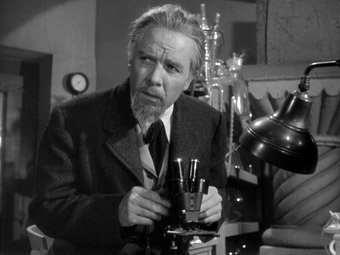
So
is it all bad news? Well, no. Like all of Universal's vampire
movies, House of Dracula does attempt to
advance the genre and does so in an interesting and forward-looking
way. As previously mentioned, this is the first genre film
to openly propose the idea of vampirism as a blood disease,
one that can be transferred from person to person through
the exchange of bodily fluid. It's something that would be taken
up by later genre works but rarely as directly as it is dealt with here – we even get to see a microscope slide of the parasite
that Edelman believes is responsible for Dracula's condition.
Once the disease is caught, its development is rapid but
uneven – Edelman appears to be able to fight it and at times
control it but at others is clearly very much its slave. Most intriguingly,
with the genre rule of vampires not
casting reflections acknowledged here, Edelman is horrified
to watch his own mirrored image slowly vanish before his
eyes, which anticipates a similar scene
in the 1987 The Lost Boys.
Stylistically,
the film also has its moments. The introduction of Nina
from behind a row of scientific apparatus appears to establish
her as Edelman's beautiful assistant in familiar style –
only when she emerges into full view is her hunched back
revealed, a condition that both drives Edelman's desire to find a cure
for her condition and sets her up as a female Igor substitute for
the Frankenstein scenes. As in the earlier Son
of Dracula, the Count transforms into
a bat on screen, but here the bat is rather good,
having the size and grace of a large sea bird. The use of
shadow as an expressionistic representation of Edelman's
darker side once he is possessed is sometimes very impressive,
and is even a little creepy when advancing on the terrified
Nina, while Dracula's demise, though undramatic, is rather
nicely done, providing brief glimpses of his muscle structure
and blood vessels before he is reduced to skeletal form.
With
its allegiance split between three monster franchises, though,
vampire lore becomes entangled with that of other Universal
horrors. Thus when Edelman becomes infected with the blood
of Dracula, he initially appears to be developing vampire
characteristics, but when he makes his first kill he tears
out the man's throat, a werewolf-like attack that prompts
blame to fall squarely on Talbot's recently operated-on
head (typical of the film's quantity-over-depth approach
sees this resolved in little more than a minute). Later,
the possessed Edelman is killed with a couple of shots from
a bog-standard revolver – no stake through the heart or
sunlight for this vampire and no silver bullet for his
werewolf tendencies, suggesting that all Dracula's blood
really did was to remove his reflection and drive him bonkers,
dulling the edge of the thematic invention of the film's
vampirism by infection proposal.
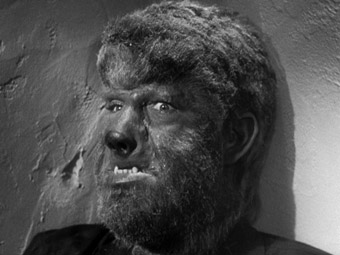
In
the end House of Dracula tries to cram
too much into too short a running time, often
doing precious little but briefly recycling a good many overly
familiar ideas and situations from earlier films. There
are some nice moments nestled in here, but they are largely
lost in the scrabble to deal with three monsters instead
of focussing on one, sometimes clumsily and never in any real depth.
It still has undeniable appeal for genre fans, despite
some poor dialogue and wooden performances, and remains
an interesting pointer to where the vampire movie sub-genre
was later to head.
Much like the transfers for Dracula's
Daughter and Son
of Dracula, House of Dracula is pleasingly free of
dust and dirt, and though there is some minor flickering
and print damage, it has been most effectively cleaned
up for this release. There are a couple of very visible
vertical scratch marks at one point, but they do not last
long. Contrast and grey levels are good, but black levels
in some of the darker scenes are not quite as solid as
they are on the other films in this set, though are never
distractingly washed out. Sharpness is reasonably good
throughout
The
Dolby 2.0 mono track is, much like the other films, clean
and free of pops and crackles. Very minor hiss is detectable
if you crank the amp up, but no more than you expect to
find on any film of this vintage.
Included
as part of Universal's Dracula: The Legacy Collection,
House of Dracula, like most of the films
included, is itself listed as a bonus feature. Otherwise
there are no features specific to this film included in
this box set, not even a trailer.
In
retrospect, this very much feels like what it is – the end
of the line for Universal's classic monsters. Dracula is
killed off unfussily, Talbot finally gets his cure (and
the girl), and the poor Frankenstein monster is persecuted
and killed just a couple of minutes after he is revived,
and for no other crime than that of rampant clumsiness. Fans of
Universal's vampire movies will still find a small place
in their heart for the film, and as part of Universal's
region 1 Dracula: The Legacy Collection
it is an essential component. That the region 2 release
includes only the first film and this one, and thus omits
the three most interesting works of the series, makes it
a no-brainer as to which one to go for. Get the region 1
release – as a package it offers excellent value for money,
and for vampire movie fans it is a virtually complete catalogue
of the vampire genre's development in the early days of
Universal studios.
|